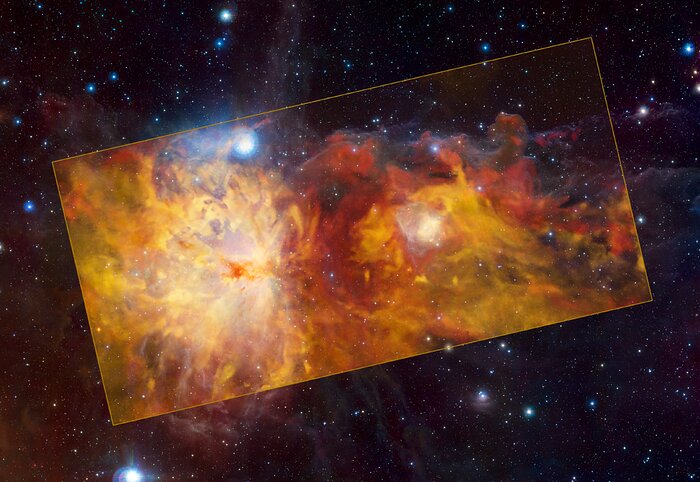Orion offers a spectacular fireworks to celebrate the Holiday Season and the New Year, in this new image from the European Southern Observatory (ESO). There is, however, nothing to worry about as this iconic constellation is neither burning nor exploding. THE fire seen on this Christmas postcard is the Flame Nebula and its surroundings, captured on radio waves — an image that does, in fact, do justice to the name of this nebula!
The image was taken with the APEX (Atacama Pathfinder Experiment), operated by ESO and installed on the Chajnantor Plateau in the Chilean Atacama Desert.
The newly processed image of the Flame Nebula, where you can also see smaller nebulae such as the Horsehead Nebula, is based on observations carried out by former ESO astronomer Thomas Stanke and his team a few years ago.
Enthusiastic about trying out the then newly installed instrument supercam at APEX, investigators pointed the telescope toward the constellation Orion.
“As astronomers like to say, whenever there's a new telescope or instrument available, we observe Orion where there's always something new and interesting to discover!” says Stanke.
A few years and many observations later, Stanke and his team now see their results being accepted for publication in the specialist journal. Astronomy & Astrophysics.
One of the most famous regions of the sky, Orion is home to the closest giant molecular clouds to the Sun — vast cosmic objects composed essentially of hydrogen, where new stars and planets form.
These clouds are located at a distance from us that varies between 1300 and 1600 light-years and contain the most active stellar motherhood that exists in the vicinity of the Solar System, in addition to the Flame Nebula seen in the image. This “emission” nebula is home to a cluster of young stars that emit high-energy radiation, which causes the surrounding gases to glow.
With such a target, the team would hardly be disappointed. In addition to the Flame Nebula and its surroundings, Stanke and colleagues were also able to observe a wide variety of other cosmic objects.
Some examples include reflection nebulae. Messier 87 and NGC 2071 — clouds of gas and interstellar dust that reflect radiation emitted by nearby stars. The team even discovered a new nebula, a small object remarkable in its almost perfectly circular shape, which was named the Cow Nebula.
The observations were carried out as part of the ALCOHOLS screening (APEX Large CO Heterodyne Orion Legacy Survey), who observed the radio waves emitted by carbon monoxide, CO, in Orion's clouds. Using this molecule to investigate large areas of the sky is the main goal of SuperCam, as this instrument allows astronomers to map huge clouds of gas where new stars form. Contrary to what the “fire” in this image might suggest, these clouds are actually cold, with typical temperatures just a few degrees above absolute zero.
Given the amount of secrets it unveils, this region of the sky has often been observed at different wavelengths, with each wavelength domain revealing different and unique structures from the molecular clouds of Orion.
As an example, there are the infrared observations carried out by the VIEW (Visible and Infrared Survey Telescope for Astronomy) from ESO at the Paranal Observatory in Chile, which make up the calm background of this image of the Flame Nebula and its surroundings.
Unlike visible radiation, infrared waves pass through thick clouds of interstellar dust, allowing astronomers to discover stars and other objects that would otherwise remain hidden.
So enter the New Year with this spectacular fireworks at multiple wavelengths brought to us by the Orion Flame Nebula and presented by ESO!
Watch the Flame Nebula video here:





















Comments